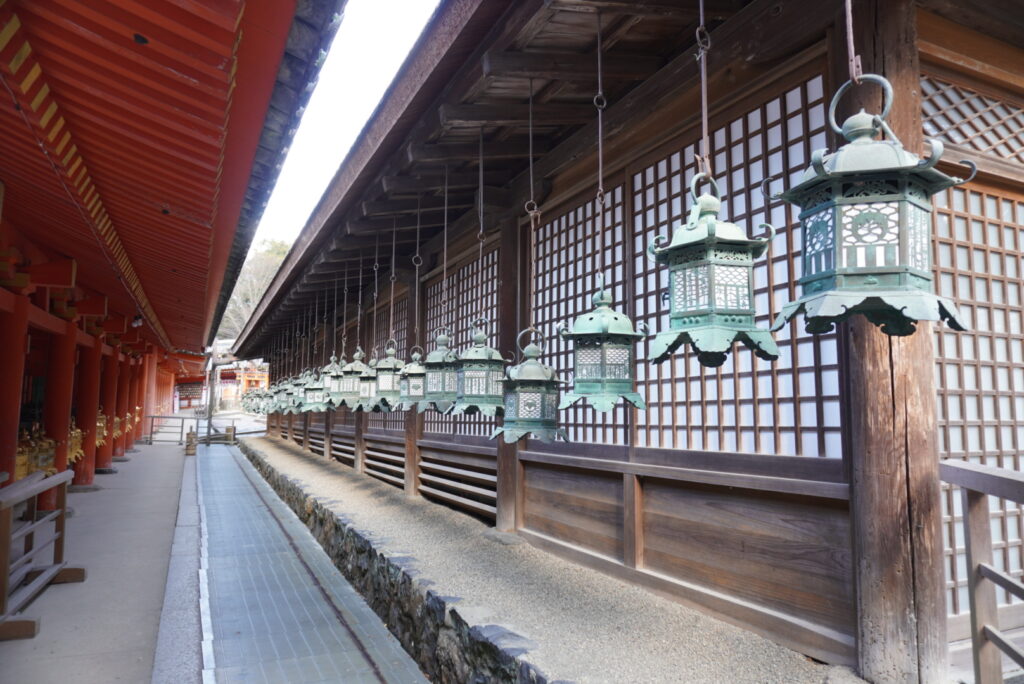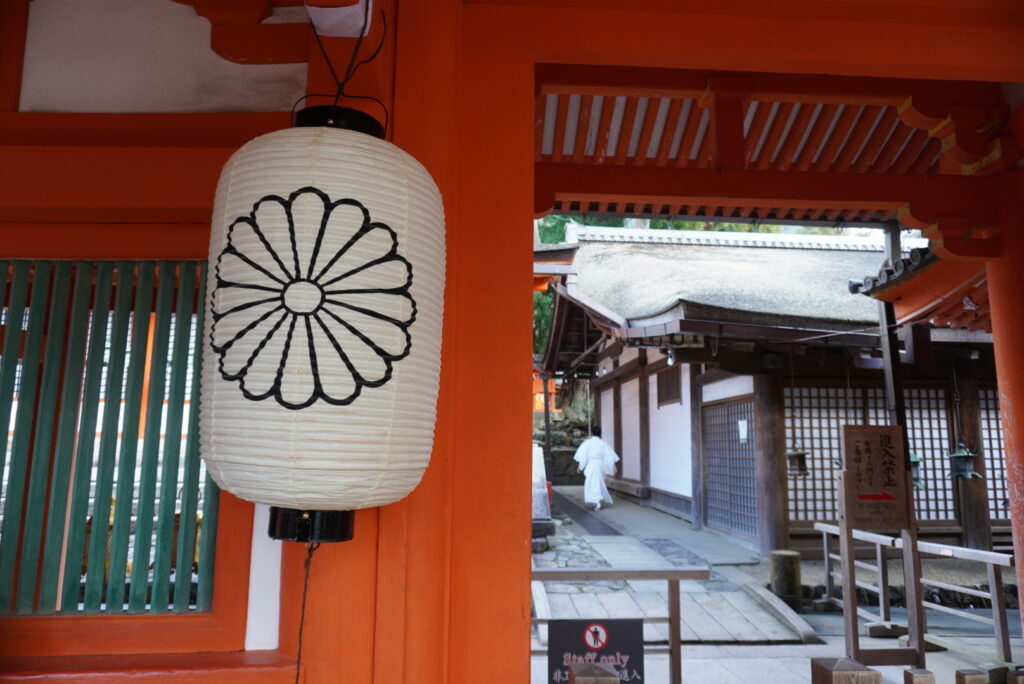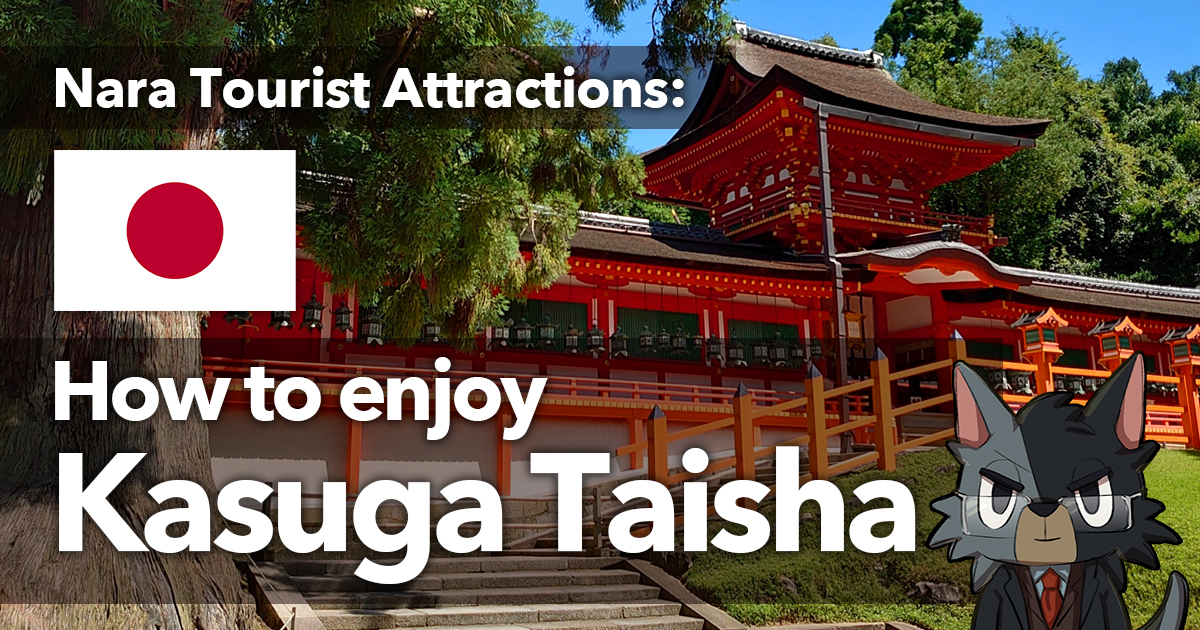Introduction

Kasuga Taisha is an important Japanese shrine located in the city of Nara and a UNESCO World Heritage Site. 768 years ago, it was founded and revered as the guardian deity of the Fujiwara clan. The shrine features vermilion-lacquered pavilions and a beautiful garden, a perfect blend of traditional Japanese architectural style and natural beauty. The charm of Kasuga Taisha lies in its historical value and cultural importance.
There are approximately 3,000 stone lanterns and 1,000 hanging lanterns within the shrine grounds, and these are the symbols of Kasuga Taisha. Especially during the “Mantoro” festival in February and August, all the lanterns are lit, creating a fantastic sight. This spectacle leaves a deep impression on visitors.
Furthermore, Kasuga Taisha Shrine offers visitors the opportunity to enjoy the beauty of nature in each of the four seasons. In spring, cherry blossoms and wisteria bloom in profusion, and in autumn, the grounds are decorated with autumn leaves. In particular, the Kasuga-yama Primeval Forest, located behind the shrine, is a beautiful, untouched natural forest where a walk will refresh your body and mind.
Kasuga Taisha Shrine is well worth a visit as a place to experience Nara’s rich history and culture. It offers a rare opportunity to experience Japanese Shinto culture through its historical architecture, beautiful nature, and traditional festivals. When you visit Nara, be sure to visit Kasuga Taisha Shrine and experience all that it has to offer.
History and Culture of the Sightseeing Spot
Historical Background
Kasuga-taisha Shrine was founded in 768 by the Fujiwara clan. The shrine was built by the Fujiwara, the political and cultural center of Japan during the Nara and Heian periods, as their guardian deity. Kasuga-taisha Shrine has been rebuilt many times throughout its long history, each time bringing together the best of cultural and architectural techniques. The current shrine pavilions were rebuilt in 1863 and feature beautiful vermilion-lacquered architecture. Kasuga Taisha is a symbol of the Shinto faith in Japan and is visited by many worshippers and tourists.
Cultural Features
The cultural features of Kasuga Taisha are its beautiful architecture and rich natural environment. The shrine pavilions are characterized by vermilion-lacquered pillars and walls, creating an elegant atmosphere. In addition, approximately 3,000 stone lanterns and 1,000 hanging lanterns are placed within the shrine grounds. These lanterns are lit during shrine festivals and special events, creating a fantastic scene.
Kasuga Taisha Shrine also offers the beauty of nature in each of the four seasons. In spring, cherry blossoms and wisteria are in full bloom, and in autumn, the grounds are beautifully decorated with autumn leaves. In particular, the “Kasuga-yama Primeval Forest,” which stretches behind Kasuga-taisha Shrine, is a sacred forest where untouched nature remains, and is registered as a World Heritage site. This forest has been untouched by man for more than 1,300 years, and is deeply inspiring to visitors.
Furthermore, many festivals and events are held throughout the year at Kasuga Taisha Shrine. In particular, the “Mantoro” festival held in February and August, when all the lanterns on the shrine grounds are lit, creates a mystical atmosphere. This festival is a long-standing tradition and attracts many worshippers and tourists.

Places to visit
Suggested times to visit
The best times to visit Kasuga Taisha are spring and autumn. In spring, cherry blossoms and wisteria flowers are in full bloom, and the beauty of the wisteria flowers, especially from late April to early May, is breathtaking. In autumn, the precincts are decorated with autumn leaves, which are at their best from mid-November to early December. Visitors should choose the right time of year to visit to enjoy the beauty of nature in each of the four seasons.
Major tourist attractions and popular places to visit
Main Shrine
The main shrine of Kasuga Taisha features beautiful vermilion-lacquered architecture. Visitors can enjoy the traditional Japanese architectural style, and its solemn atmosphere is worth seeing. In front of the main hall, there are approximately 1,000 hanging lanterns, and the “Mantoro” festival, when these are lit, is especially worth seeing.
Wisteria trellis
The wisteria trellis at Kasuga Taisha is a popular spot visited by many tourists from all over Japan. In spring, visitors can enjoy the beautiful blooming of purple wisteria flowers and their fragrance as well as the fantastic scenery. In particular, the wisteria trellis at the Otabisho is spectacular and a popular photo spot.
Kasuga-yama Primeval Forest
The Kasuga-yama Primeval Forest is a sacred forest of untouched nature that stretches behind Kasuga Taisha Shrine. It is registered as a World Heritage site and has been protected for over 1,300 years. A stroll through this forest will allow you to experience the beauty and tranquility of nature. It is a spot where you can refresh your mind and body.
Hobonden (Hall of Treasures)
The Treasure Hall displays valuable cultural assets and artifacts from the Kasuga Taisha Shrine. Visitors can experience Japanese history and culture, and the exhibits of ancient armors and portable shrines are especially worth seeing. Visit to deepen your cultural knowledge.

Points of Attention at Sightseeing Spots
When visiting Kasuga Taisha Shrine, please note the following points:
- Crowded: It is very crowded, especially during the spring and fall tourist seasons and festivals. If you visit early in the morning or late in the evening on a weekday, you will be able to see the shrine more comfortably.
- Clothing: Wearing comfortable shoes is recommended as you will be walking through the large precincts of the temple. Also, please dress appropriately for the season.
- Manners: Kasuga Taisha is a sacred place. When visiting the shrine, please observe the rules of etiquette and visit quietly. Photography is prohibited in some areas, so please visit with caution.
- Nature Conservation: The Kasuga-yama Primeval Forest is a precious place where untouched nature remains. Please walk around with good manners and do not take trash home with you or damage the nature.
Access
Access from Nara Station
Access to Kasuga-taisha Shrine from Nara Station is very easy: take the city circulation bus from JR Nara Station or Kintetsu Nara Station and get off at the Kasuga-taisha Omotesando bus stop. The bus ride takes about 10 minutes, and the approach to Kasuga-taisha Shrine is about a 5-minute walk from the bus stop. You can also reach Kasuga Taisha Shrine on foot from Kintetsu Nara Station in about 20 minutes. It is recommended that you take a walk through Nara Park on the way to the shrine.
Access from Shin-Osaka Station
The most convenient way to get to Kasuga Taisha Shrine from Shin-Osaka Station is by train. First, take the JR Tokaido Line from Shin-Osaka Station, change to the JR Yamatoji Rapid at Osaka Station, and get off at Nara Station. The trip takes about one hour. From Nara Station, as mentioned above, you can access Kasuga Taisha Shrine by bus or on foot. Another route is to take the Midosuji Subway Line from Shin-Osaka Station and transfer to the JR Yamatoji Rapid at Tennoji Station, which also takes about one hour to Nara Station.
Access from Kansai International Airport
There are two ways to get to Kasuga Taisha Shrine from Kansai International Airport: by train or by bus. If using a train, take the Nankai Railway to “Namba Station”, then transfer to the Kintetsu Nara Line and get off at “Kintetsu Nara Station”. The trip takes about one and a half hours. From Kintetsu Nara Station, you can access Kasuga Taisha Shrine on foot or by bus. By bus, there is a direct limousine bus service from Kansai Airport to Nara, which takes about 1.5 hours to reach Nara Station. From Nara Station, Kasuga Taisha can be reached by bus or on foot.
Hours of Operation, Admission Fees
Business Hours
Kasuga Taisha Shrine’s hours of operation vary depending on the season and facilities. The main area, the main hall, is usually open from 6:30 am to 5:30 pm. However, during the winter season (November through February), it is open from 7:00 a.m. to 5:00 p.m. Opening hours may change during special events and festivals, so it is recommended to check the official website for the latest information before visiting.
Admission Fees
The grounds of Kasuga Taisha itself are free to enter, but certain areas require an admission fee.
Main Shrine
Special visit to the main shrine is charged and costs 500 yen for adults and 300 yen for children. During the special visit, visitors can go up close to the main hall, which is normally inaccessible, and receive detailed explanations.
Treasure Hall
Admission to the Treasure Hall is 500 yen for adults, 300 yen for university and high school students, and 200 yen for junior high and elementary school students. Here visitors can view valuable cultural assets and artifacts from the Kasuga Taisha Shrine. Special exhibitions are sometimes held, and admission fees may be set separately.
Cautions
When visiting Kasuga-taisha Shrine, please pay attention to the times of year and times of day when the shrine is crowded. Especially during the cherry blossom season in the spring, the foliage season in the fall, and during special festivals, the shrine attracts a large number of visitors and worshippers. Visiting early in the morning or late in the evening on a weekday allows for a more relaxed visit. Also, please be sure to observe the etiquette of a religious site and visit in a quiet manner.
Summary
Kasuga Taisha is located in Nara City and is a historic shrine founded by the Fujiwara clan in 768. It features a beautiful vermilion-lacquered shrine pavilion, 3,000 stone lanterns and 1,000 hanging lanterns, and is a particularly fantastic sight during the “Mantoro” festival in February and August. Visitors can also enjoy nature in each of the four seasons, with cherry blossoms and wisteria blooming in spring and autumn leaves beautifully decorating the grounds in fall. The Kasuga-yama Primeval Forest is registered as a World Heritage site and is a sacred forest where untouched nature remains.
Visit Kasuga Taisha Shrine and enjoy its history, culture, and beautiful nature. You will have a wonderful and memorable experience as you experience Nara’s rich traditions and beauty.



